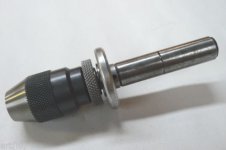Laverda
Cast Iron
- Joined
- Mar 24, 2014
- Location
- Riverside County, CA
I need to drill some holes in brass using a number 78 drill which is .016" diameter. They are through holes and I am drilling a 1/4" thick brass rod held in a collet. The drill bits keep breaking! I have never used a drill bit this small. I am sure I am doing everything wrong. I don't have a small drill press, just a big 1950's Rockwell drill press that only spins up to 2400 RPM. Probably not fast enough. Although my Bridgeport will spin faster than this, it provides even less feel as to what the drill bit is doing before it breaks.
I am guessing I have the wrong machines to do this job? Drilling by hand is not an option as the holes won't be the size I need do to the drill moving around.
Spending money on the proper small precision drill press is not a good option for a one time job.
Anyone ever used one of the attachments that converts a Dremel tool in to a drill press as mine will spin up to 35,000 RPM? I don't have the attachment but may get one if it will work.
I am guessing I have the wrong machines to do this job? Drilling by hand is not an option as the holes won't be the size I need do to the drill moving around.
Spending money on the proper small precision drill press is not a good option for a one time job.
Anyone ever used one of the attachments that converts a Dremel tool in to a drill press as mine will spin up to 35,000 RPM? I don't have the attachment but may get one if it will work.




